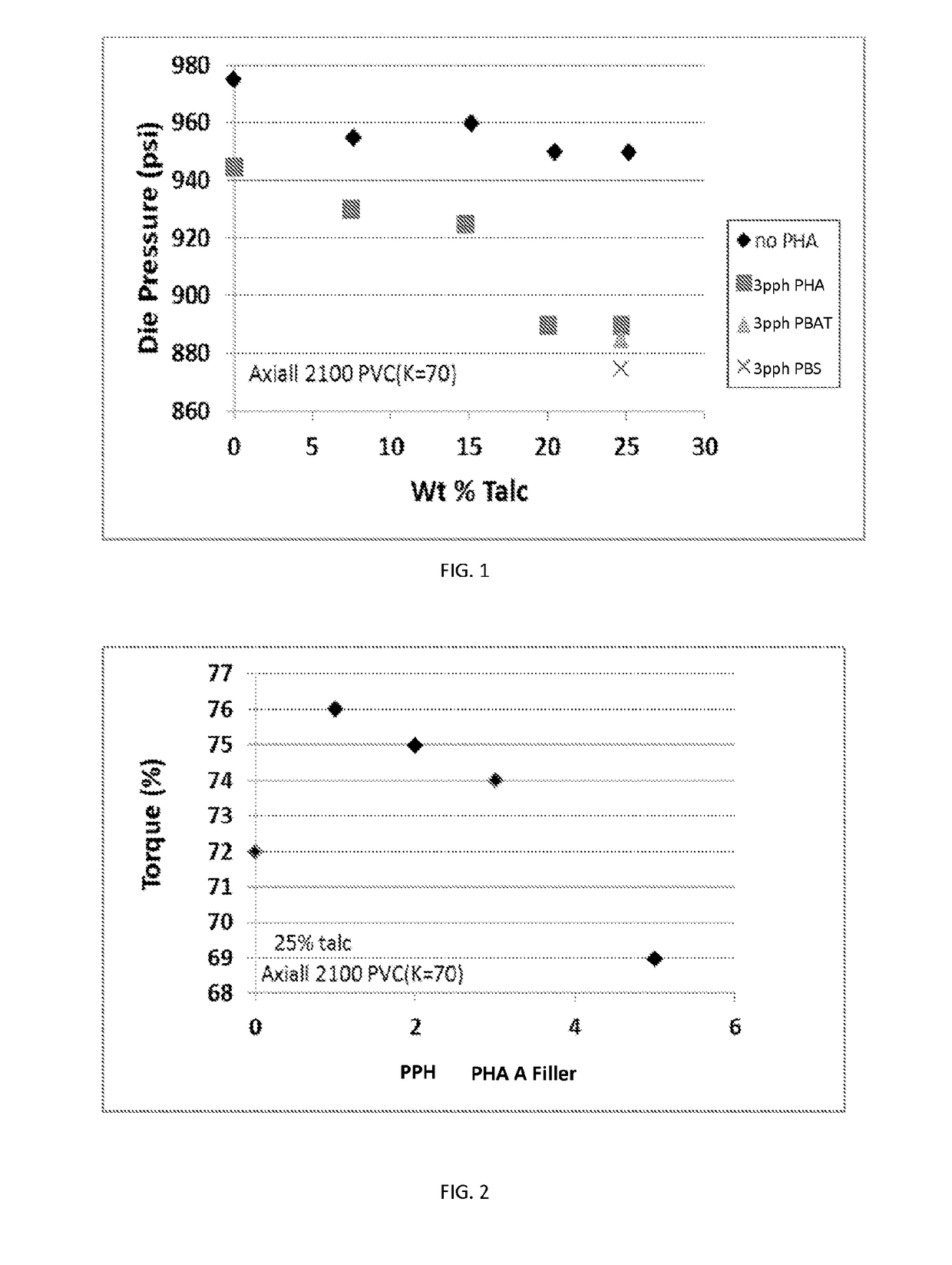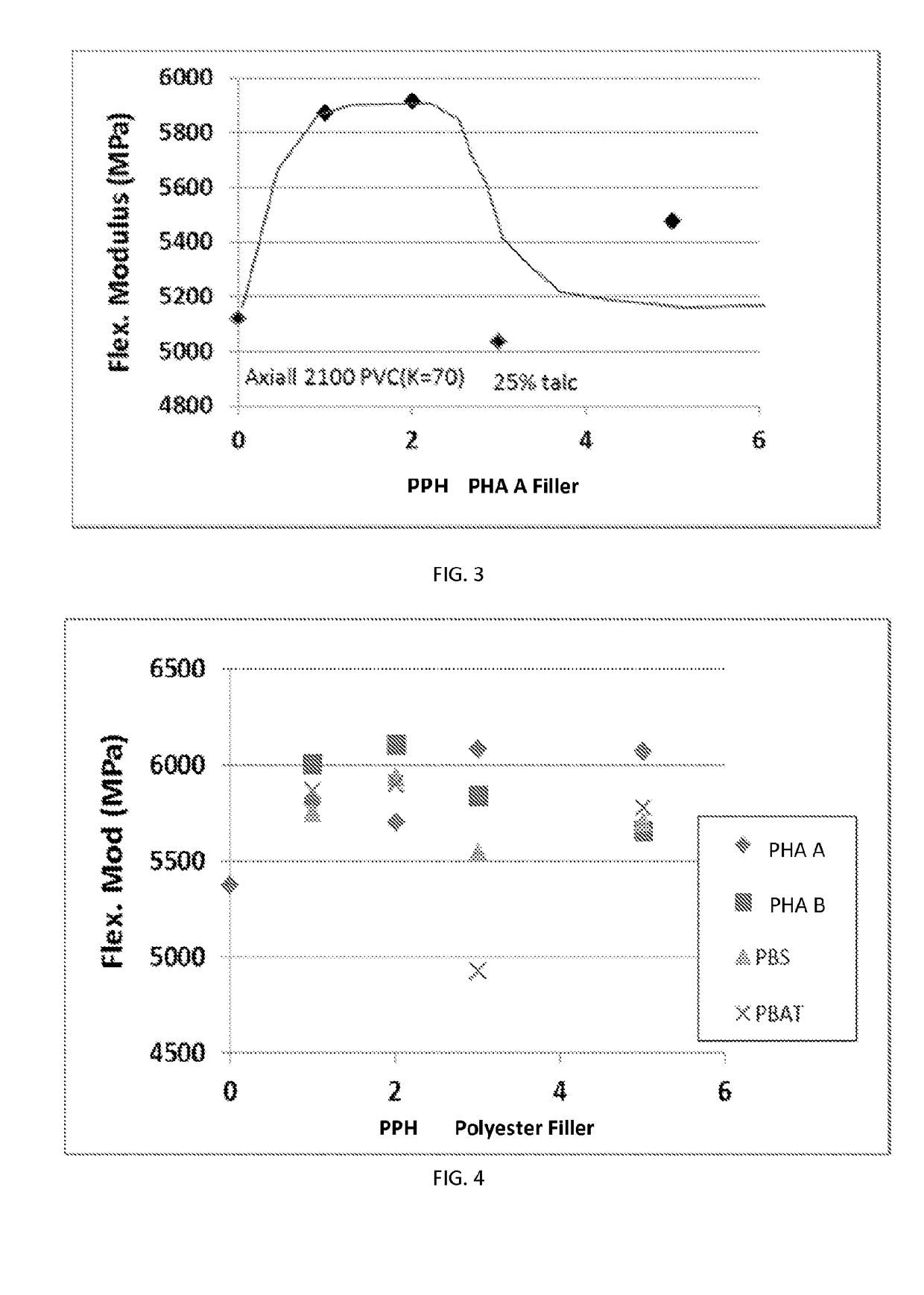Highly filled polymer systems
a polymer system and high-filling technology, applied in the field of high-filling polymer systems, can solve the problems of difficult and costly extrusion of such pvc formulations into finished products, more impaired physical properties of final products, etc., and achieves the effects of reducing the use of petroleum-based plastics, reducing the use of filler, and increasing the loading
- Summary
- Abstract
- Description
- Claims
- Application Information
AI Technical Summary
Benefits of technology
Problems solved by technology
Method used
Image
Examples
example 1
Talc Filled Rigid PVC With PHA A, PBAT or PBS Polyester Additives
[0111]In this example rigid PVC is compounded with various polyester additives and the effect on processing variables such as torque and die pressure as well as mechanical properties such as flexural modulus are described.
[0112]PVC was blended with 1 phr of MARK® 1900 (Chemtura Corp.) organotin stabilizer in a high shear mixer. This blend was then mixed with FLEXTALC® 610D (Specialty Minerals) and one of the polyester processing aids PHA A, PHA B, PBAT (ENPOL® PBG7070, Samsung Chemicals) or PBS (ENPOL® G4560-ME272) and fed to a Prism 16 mm twin screw extruder. The extruder was operated with a temperature profile of 170° C. / 175° C. / 175° C. / 180° C. / 180° C. / 180° C. / 180° C. / 180° C. / 180° C. / 170° C. (zones 1 to 10) at 150 rpm. The feed rate was between 4 and 6 lbs / hr. Torque was measured during extrusion of the PVC blends and is represented as the percentage of maximum shaft torque output for the extruder which was reported ...
example 2
Talc Filled Rigid PVC With PHA B Polyester Additive
[0117]Blends of PVC with PHA B were prepared as outlined in Example 1 having 25% by weight (34 pph) talc and 1 pph MARK® 1900 stabilizer added. The formulations for these are shown below in Table 2.
TABLE 2Summary of PVC / PHA B blend formulations. Concentrationsfor the components in the Formulations are in parts-per-hundred(pph) PVC._The weight % talc is also given below.Formulation9101112PVC100100100100Stabilizer1.01.01.01.0PHA B1235Talc34343434(25 wt. %)(25 wt. %)(25 wt. %)(25 wt. %)
Samples of each formulation were collected, molded and tested for flexural modulus as outlined in Example 1.
[0118]FIG. 4 compares the change in flexural modulus with parts-per-hundred polyester filler (PHA A, PHA B, PBAT and PBS) in PVC. The results show that the all of the polyester additives increased the Flexural modulus of the PVC blend up to 5 pph addition. Data for torque vs. weight percent polyester additive also showed that PBAT significantly inc...
example 3
Processing of Rigid PVC With PHA A and PHA B Polyester Additives
[0119]In this example, rigid PVC blends were prepared with the addition of both PHA A and PHA B polyester additives. The blends processing characteristics were evaluated using a Torque Rheometer.
[0120]The PVC formulations, shown in Table 3, were first blended at 2000 rpm in a high speed mixer, which generated shear heat during the process. The PVC resin was introduced at ambient temperature to the mixer. Within 3 minutes as the shear heat built-up within the mixer, organotin stabilizer (MARK® 1900, Chemtura Corp.) was then introduced at 120° F., followed by the lubricant (calcium stearate), wax (oxidized polyethylene, Honeywell) and processing aids (PHA A and PHA B) at 140-150° F. The fillers calcium carbonate (SUPER-PFLEX® 100, Minerals Technologies) and talc (MISTRON® VAPOR R, Imerys) were then charged to the mixer at 190° F. The entire blending process was completed at a final temperature of 225-235° F. Once the blen...
PUM
| Property | Measurement | Unit |
|---|---|---|
| weight % | aaaaa | aaaaa |
| weight % | aaaaa | aaaaa |
| weight | aaaaa | aaaaa |
Abstract
Description
Claims
Application Information
 Login to View More
Login to View More - R&D
- Intellectual Property
- Life Sciences
- Materials
- Tech Scout
- Unparalleled Data Quality
- Higher Quality Content
- 60% Fewer Hallucinations
Browse by: Latest US Patents, China's latest patents, Technical Efficacy Thesaurus, Application Domain, Technology Topic, Popular Technical Reports.
© 2025 PatSnap. All rights reserved.Legal|Privacy policy|Modern Slavery Act Transparency Statement|Sitemap|About US| Contact US: help@patsnap.com



